Who needs to skip around musical history in a concert? A hundred years ago the musical world was in ferment, with shocking new developments right before and after World War I. The Montreal Symphony Orchestra placed its entire concert Monday evening in an eight-year compositional period between 1913 and 1921, with terrific results.
Universally known in the musical world as the OSM or the Orchestre symphonique de Montréal, the Montrealers tugged hard at the linkage between French and Russian musical strains that set the musical world on fire in the second decade of the 20th century. A spectacular run through Sergei Prokofiev’s Piano Concerto No. 3 by 25-year-old Russian wunderkind Daniil Trifonov led to a coruscating performance by the OSM of Igor Stravinsky’s The Rite of Spring.
I’m happy to report that there were no fistfights in the nice crowd at the Kennedy Center Concert Hall as there were at The Rite of Spring’s first performance in Paris in May 1913. Either the Washington audience was too taken in by the sight of the OSM jamming every corner of the stage – no tear-inducing budget cuts for this band, with the telltale listing of 14 viola players and 12 cellists for the OSM’s U.S. tour – or their ears were still buzzing from Mr. Trifonov’s channeling of Prokofiev’s wildly inventive spit and sparkle.

Daniil Trifonov (don’t stress over the name – say “dan-YEEL TREEF-a-noff” and you’ve got it) brings a unique vibe to the concert stage that can only bode well for a potential new global audience of millennial classical music fans. With his mop of stringy hair topping a lanky figure dressed in retro-cool dark suit and skinny tie, Mr. Trifonov alternately sits ramrod-straight in what appears to be almost a catatonic state of concentration or bends completely over the piano peering at the keyboard as if it’s a chessboard with a difficult position to solve. Which is particularly appropriate as Prokofiev was almost as fanatical about chess as he was about music.
Together with OSM conductor Kent Nagano, Mr. Trifonov made the most of the bold moment-to-moment contrasts that keep Prokofiev’s third concerto near the top of the list of 20th-century serious music hits. Mr. Nagano pulled back the enigmatic, questioning melody in dual clarinets that opens the concerto an extra hair in tempo from the usual. That provided an additional contrast to the following motoric race that the orchestra sets off on before the piano entrance that Marc Wieser’s program notes brilliantly labeled a “joyful yelp.”
From there it was all special sauce by Mr. Trifonov. Partway through the first movement, the piano imitates the opening orchestra run with a crazily twisting motion up the keyboard in the right hand that is joined halfway through by the left hand an octave below. Most often a pianist will sneak in the left hand, resulting in a straight-line crescendo or volume increase up to the main melodic motive. Instead Mr. Trifonov made the left-hand entrance an unmistakable initial growl added to the right-hand motion. Then he pulled back the dynamics in both hands to prepare for a renewed volume increase in a race to the main melody at the top.

Mr. Nagano added many analogous buttons and volume shifts to the beginning and middle of orchestral lines to keep the entire concerto fresh and appropriately unpredictable throughout. The second movement – a quirky, ironic-sounding gavotte with five variations ranging from lamenting wistfulness to jazzy figurations – was handled with great contrast by the pianist and orchestra. The third movement featured astonishing octave-work by Mr. Trifonov, creating especially piquant colors against the upper woodwinds. The fact that he took the most rapid passages of the concerto just a bit faster than it’s often heard – because, well, he can – just added to the event-like nature of the evening.
Mr. Trifonov’s killer performance was also well positioned, as it completed the first half of a concert in which the audience seemed a bit unsettled by the opening orchestral number, Claude Debussy’s Jeux (meaning “Games”). This 15- to 20-minute composition theoretically depicts a somewhat disorganized twilight game of tennis between one boy and two girls, complete with an advanced degree of Debussy’s highly coloristic orchestral texture.
A difficulty with hearing this music disembodied from its original ballet setting is that the music is cellular rather than cyclic, meaning that the orchestra spends a brief period on each theme before discarding it and moving onto the next in a largely inconclusive progression. It’s one that makes sense if you remember that the point is very likely not who wins or loses some tennis match, besides which much of the music seems to suggest chasing after lost tennis balls, just as in real life.
Less imagination was required to comprehend the OSM’s performance after intermission of Stravinsky’s The Rite of Spring, which not only has a literal set of stated scenes based on Russian pagan traditions but is etched in very bold colors. For once I was pleased to hear a work in the specific acoustic of the Kennedy Center Concert Hall, which is easy to criticize in other contexts. In the boxy room the OSM’s brass notes had a great bite without getting “rounded out” as they would in an airier setting, while still never descending into an inappropriate blare.
The OSM’s huge string sections delightedly laid into the syncopated rhythms of the various dance motives representing earth and sacrificial themes. Special note has to be made of the bassoon and contrabassoon work which cut right through the splendid cacophony, and made up for some initial lack of clear mix from the woodwinds in the earlier Debussy work.
Mr. Nagano, who is a native-born American from California’s central coast (in ironic contrast to Montreal native Yannick Nézet-Séguin, who currently leads the Philadelphia Orchestra) provides clean vertical beats with his baton hand, suitably reemphasized with the energy of his upper torso, that are perfectly paired with lyrical and interpretive motives from his left hand. In case conducting technique seems redundant for a professional orchestra, it’s not in the case of a tour where the orchestra has one shot in each venue with a fresh playing atmosphere.
Washington was the first stop in the OSM’s nine-city U.S. tour this month. It was a great way for them to start, and kudos to Washington Performing Arts for bringing the OSM to D.C. for the first time in 30 years. In brief opening remarks, Washington Performing Arts President Jenny Bilfield teasingly implied that Mr. Trifonov will be back here for a solo concert next season. I wouldn’t mind seeing the entire orchestra back in town soon as well.
Running Time: 2 hours and 10 minutes, with one 15-minute intermission.
The Montreal Symphony Orchestra with Pianist Daniil Trifonov, presented by Washington Performing Arts, was performed on Monday, March 14, 2016 at 7 p.m. in the Concert Hall at The John F. Kennedy Center for the Performing Arts – 2700 F Street, NW, in Washington, DC. For future events presented by Washington Performing Arts, see their season calendar.




